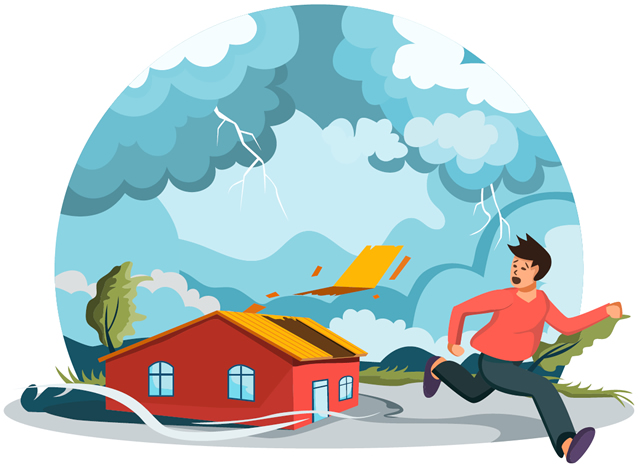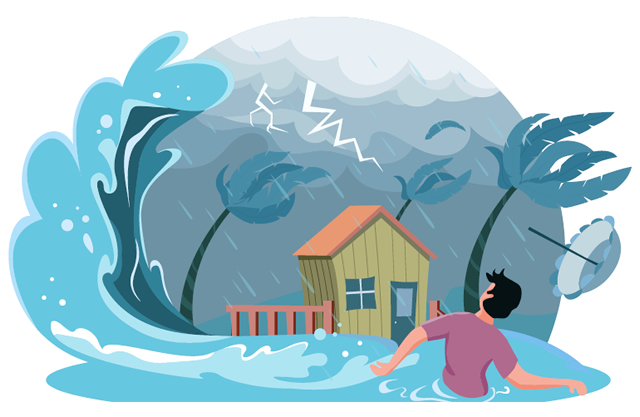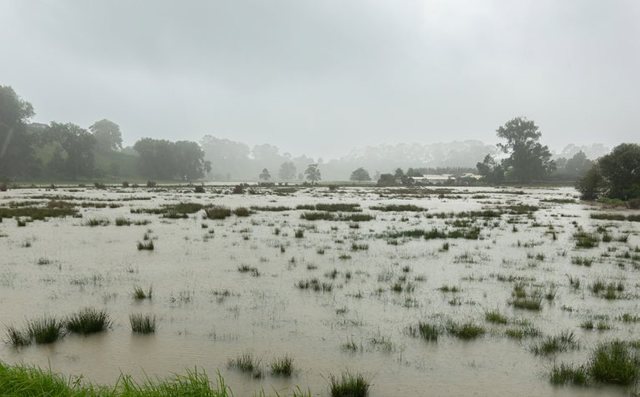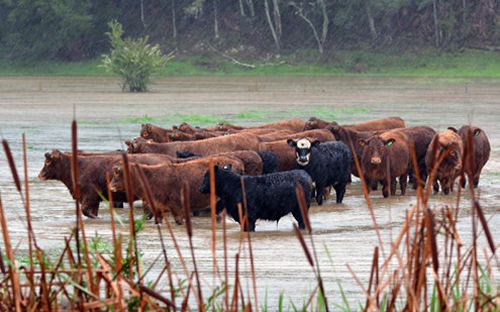 Welcome to the Autumn 2023 edition of Rural eSpeaking.
Welcome to the Autumn 2023 edition of Rural eSpeaking.
We hope you find all the content in Rural eSpeaking to be both useful and interesting.
This issue is focussed on the effects of recent severe weather events, in particular the unwelcome visits of Cyclones Hale and Gabrielle, and how our readers in the rural sector can mitigate against the effects of these storms.
Download Rural eSpeaking, Autumn 2023 (PDF)
Severe Weather Emergency Legislation Act 2023
Assisting recovery and improving resilience
The severe weather events this year, in particular Cyclones Hale and Gabrielle, highlighted the need to amend some legislation to assist recovery and improve resilience for areas that have been impacted.
The Severe Weather Emergency Legislation Act 2023 is the government’s response to legislation that can be amended to improve emergency response and reduce regulation. Having come into force on 21 March, the Act amends these four statutes:
- Civil Defence Emergency Management Act 2002 (CDEM)
- Resource Management Act 1991 (RMA)
- Food Act 2014 (FA) and the Food Regulations 2015 (FR), and
- Local Government Act 2022 (LGA).
Civil Defence Emergency Management Act 2002
Amendments to the CDEM address issues relating to concurrent declarations of states of emergency and notices of transition periods, and how resources dedicated to emergency response are used.
Group recovery managers appointed under the CDEM are responsible for coordinating the recovery activity within the region they are appointed. The Act clarifies that they must not use their powers, in respect of resources, for the benefit of a current emergency response if it is contrary to the priorities of an ongoing transition period in the region.
Resource Management Act 1991
Changes to the RMA slightly reduce the level of red tape following significant weather events. These changes lower the level of notice required by an authority to enter land in response to an emergency, and increase the ability for owners or occupiers of land to conduct emergency work and preventative remedial actions. Cyclones Hale and Gabrielle, as well as the heavy rainfall in Northland, Auckland, Waikato and the Bay of Plenty, are listed as ‘severe weather events’ with areas impacted by these events being ‘affected areas.’
Formerly a local authority or consent authority entering any place to take an action to remove the cause of, or mitigate any actual or likely adverse effect, of an emergency, had to give notice to the occupier. This has now been modified so that the authority only needs to display a prominent notice on the land and, as soon as practicable, a notice containing the same details is to be served on the ratepayer.
Under the old legislation, the notice required a person who had undertaken emergency works, or preventive or remedial action, to give notice of that activity within seven days and apply for any appropriate resource consents within 20 working days (if the activity contravened sections 9, 12, 13, 14 and 15 of the RMA). These times are now extended to 100 working days and 160 working days respectively. The same extension has been applied where emergency work is undertaken under the CDEM via section 330C.
These extensions will revert back to the previous timeframes on 1 April 2025.
Immediate preventive or remedial measures to avoid, remedy or mitigate loss, injury, detriment or damage caused by a severe weather event undertaken by an owner or occupier of rural land is now a permitted activity under the RMA.
However, any activity classified as a prohibited activity in a relevant plan, any applicable regulations or national environmental standards will not be a permitted activity. Written notice must be provided to the relevant consent authority within 60 working days after starting the activity and, if the requisite notice is not given, the permitted activity status is revoked from the date on which the notice period ends. This will end on 1 October 2023 and the previously listed activities will no longer be permitted by default.
These sections aim to provide short-term relief for rural owners and occupiers to begin remedial work after the recent severe weather events without having the requisite resource consent as long as they are not listed as prohibited activities elsewhere.

Food Act 2014 and the Food Regulations 2015
Under the FA and FR, a food business is a business, activity, or undertaking that trades in food, whether in whole or in part. The FA and FR apply to food for sale as well as food-related accessories.
The Act acknowledges that compliance with the FA and FR registration and verification requirements may not have been possible for some food business owners during recent severe weather events in Northland, Auckland, Waikato, Bay of Plenty, Gisborne and Hawke’s Bay and the districts of Tararua, Masterton, Carterton and South Wairarapa (collectively referred to as ‘affected areas’).
If a food business in an affected area had their registration expire, or their registration is due to expire, between 8 January and 16 May 2023, they are provided with an extension for registration until 16 May 2023. A food business owner may continue to operate beyond this period provided they have paid the required fee for renewal of their registration.
 Under the amended FR, food business owners in an affected area that were due to comply with regulations 87(1), 88(1) or 90 between 8 January 2023 and 16 May 2023 and regulations 91(1), 92(1), 93(1) or 94 between 8 January 2023 and 16 August 2023 are now exempt from doing so. However, if an operator of a food business benefits from an exemption they must resume compliance when they are next required to so in accordance with the FR.
Under the amended FR, food business owners in an affected area that were due to comply with regulations 87(1), 88(1) or 90 between 8 January 2023 and 16 May 2023 and regulations 91(1), 92(1), 93(1) or 94 between 8 January 2023 and 16 August 2023 are now exempt from doing so. However, if an operator of a food business benefits from an exemption they must resume compliance when they are next required to so in accordance with the FR.
Local Government Act 2002
Local authorities may amend existing long-term plans (being plans for the period 1 July 2021 to 30 June 2024) to include matters relating to water services so that they may respond to the damage that has been caused to water infrastructure as a result of Cyclone Gabrielle.
Local authorities and Civil Defence Emergency Management Groups now may also meet by audio or audiovisual link.
There is a great deal to digest with these changes; if you have any queries or need some help, please don’t hesitate to contact us.
Leased land impacted by Cyclones Hale and Gabrielle
Some options for lessees
The damage caused to land by the recent weather events across New Zealand has raised concerns about the ongoing viability of leased land that has been impacted by these storms. Depending on a lessee’s particular circumstances, there are options in terms of relief from rental payments or, in the more extreme circumstances, termination of the lease.
If you are a lessee, the Property Law Act 2007 (PLA) and the law of frustration of leases may provide you with options when the land subject to the lease has been damaged or destroyed. ‘Frustration’ in the legal context means a contract that, subsequent to its formation and without fault of either party, is incapable of being performed.
Property Law Act 2007 implied terms
 Section 218 of the PLA implies a list of covenants, conditions and powers in all leases. An ‘implied term’ is what is included in a lease by statute. These terms allow a lessee to seek relief from rent payments or to cancel the lease.
Section 218 of the PLA implies a list of covenants, conditions and powers in all leases. An ‘implied term’ is what is included in a lease by statute. These terms allow a lessee to seek relief from rent payments or to cancel the lease.
If the land you lease has been destroyed or damaged, the PLA1 may provide you with rent relief in proportion to the destruction or damage caused. Events that may lead to rent relief include floods and storms. If you are at fault for the event that caused the destruction or damage, such as being responsible for the cause of flooding, you will not be entitled to a rent reduction until the damage is repaired.
If your lease states that the land may be used for one or more specified purposes such as cropping, and during the term of the lease that land can no longer be lawfully used for cropping, you may be able to terminate the lease. An example would be if land was ‘red zoned’ so couldn’t be legally used for cropping any more2. As with rent relief, if you are at fault for the land not being able to be lawfully used for the specified purpose, you will not be able to cancel the lease.
Under the terms implied in all leases found in the PLA, you must keep the leased property in the same condition that it was in when the lease term began. However, this does not apply to reasonable wear and tear and events such as floods and storms, unless you are at fault. This means that if the land you lease has been damaged by flood and your lease is due to expire soon, on termination you are under no obligation to restore the land to the condition it was in at the beginning of the lease.
Your lease may include a clause that states any implied terms found in the PLA that are inconsistent with a specific term of the lease will not apply. Before signing a lease, you should review these specific terms to check for any inconsistency with the implied terms set out at schedule 3 of the PLA.
Force majeure
Some leases may include a ‘force majeure’ clause that covers what is colloquially referred to as ‘Acts of God.’ These include events such as floods, earthquakes or, more recently, pandemics. These clauses typically provide for the lease to be terminated, or provide that the parties’ obligations, such as payment of rent, under the lease are to be suspended for a period of time.
‘Frustration’ and rural leases
Recently, leases have been recognised for their contractual nature not just as an interest in land. ‘Frustration’, which is a remedy to cancel contracts, can now be used to cancel a lease.
When there is a radical change in circumstances outside of your control, such as a cyclone damaging the leased land, you may use the remedy of frustration to cancel the lease. Your lease will be cancelled effective from the date of the event. An example of this situation would be if a river changed its course (which did happen in Gabrielle), making it impossible to farm the land, you could claim the lease was ‘frustrated’ so should end from the date the river changed course.
When deciding if a lease could be cancelled via frustration it is important to look at the purpose of the lease and the length of the remaining term. To be successful in using frustration to end a lease, the purpose of the lease will need to be unable to be carried out during the remainder of the lease term. If your lease has a lengthy term remaining, it is less likely it will be frustrated by an event such as a storm that renders the land unusable for a short period of time.
So far in 2023 there have been a handful of severe weather events that have caused significant damage to leased land. As these climate change-related events become more common, we are likely to see frustration being more commonly used to attempt to cancel leases.
If you are unsure about the terms of your lease after Hale and/or Gabrielle, or any other the other significant weather events that have recently occurred in New Zealand, please don’t hesitate to contact us. We are here to help.
1 Property Law Act 2007, s4 of schedule 3.
2 Ibid, s10 of schedule 3.
Over the fence
Resource Management (National Environmental Standards for Freshwater) Regulations 2020 now amended
Wetlands have many environmental benefits; they can significantly reduce nutrient and sediment losses on farms, improve water quality, and provide a habitat for birds and fish.
 In 2020, Resource Management (National Environmental Standards for Freshwater) Regulations were introduced. These regulations protected wetlands to preserve their environmental benefits. The initial regulations had limited consenting pathways and resource consents were not obtainable for the construction of any water storage facility that could adversely impact the extent or values of the wetland. In January 2023, these regulations were amended to introduce new consenting pathways for the purposes of:
In 2020, Resource Management (National Environmental Standards for Freshwater) Regulations were introduced. These regulations protected wetlands to preserve their environmental benefits. The initial regulations had limited consenting pathways and resource consents were not obtainable for the construction of any water storage facility that could adversely impact the extent or values of the wetland. In January 2023, these regulations were amended to introduce new consenting pathways for the purposes of:
- Urban development
- Quarrying activities
- The extraction of minerals and ancillary activities (with additional controls on coal mining)
- Landfill and cleanfill areas, and
- Water storage, ski area infrastructure and New Zealand Defence Force activities, that are included in the definition, and the existing National Environmental Standards for Freshwater provision for ‘specified infrastructure.’
There are certain ‘gateway tests’ under the new consent pathways that must be satisfied before consent is granted.
The effects of the activity must also be managed using the ‘effects management hierarchy.’ This addresses any adverse effects the activities may have on the extent or value of the wetland. There are also certain conditions imposed on the new consenting pathways, including the requirement that water storage infrastructures must provide significant national or regional benefits.
Affordable Water Reform replaces Three Waters Reform Programme
On 13 April 2023, the government announced changes to its Three Waters Reform Programme. Three Waters was introduced in 2022 to change the delivery of drinking water, wastewater and stormwater to ensure all New Zealanders have safe and reliable water infrastructure. After a significant negative public response to the Three Waters proposal, the government has made key changes to what is now called Affordable Water Reform. These are:
- Ten publicly owned specialised service entities rather than four
- The entities will be based around the existing regions and will be connected to the communities that they serve
- The entities will be owned by local councils and will be operationally and financially independent
- Each entity will be governed by a professional board and local input will be enhanced through the regional representative group for each entity. There will be an equal number of mana whenua and council representatives on each entity’s regional representative group, and
- The introduction of the entities will occur through a staged approach between early 2025 and 1 July 2026 at the latest.
The original Better-Off funding model was designed to support councils through the transition period and to manage the financial impacts of the reforms. The Crown will still provide Better-Off funding for the first phase ($500 million) but not for the second phase ($1.5 billion). The first phase of funding has been implemented to try to negate the financial implications that the councils face during the transition.
The latest amendments do not largely impact the Water Services Legislation Bill and the Water Services Economic Efficiency and Consumer Protection Bill currently before Parliament. The government intends to pass legislation to implement these new changes before the election in mid-October.
Reaction to the changes to the government’s revised water reform programme has, it is fair to say, been mixed. It will be interesting to see how these reforms progress over the next six months before the election.
Cyclone Gabrielle – animal welfare management
Cyclone Gabrielle had a significant impact on farms in the North Island and left many animals stranded and in danger. This has highlighted the importance of having a disaster management plan in place which sets out what is required to keep your stock and pets safe.
When preparing for a disaster there are a range of factors to consider including:
- What items should be included in an emergency kit, such as necessary food, medicine and water
- Where the emergency kit will be stored so that it is accessible in the event of a disaster
- Evacuation routes
- Where animals can be safely stored in the event of a disaster including high points and well sheltered areas
- What will happen with the animals while your property is restored, and How will your animals be cared for if your property is damaged?

When a disaster occurs it can greatly impact the health of your animals. They are often stressed from the disaster which weakens their immune systems and increases their risk of becoming sick. As medical supplies are usually difficult to obtain following a disaster, it is important to ensure that you always have sufficient supplies on hand to keep your animals healthy.
There is also the possibility that stock feed could be damaged as a result of the disaster. Following Cyclone Gabrielle, the floodwaters caused some feed to become contaminated with sewage, bacteria, chemicals and other toxins. Moisture also increases the risk of mould.
As a part of your disaster response planning you need to consider what will happen where there is limited feed, including what animals take priority such as animals that are pregnant or newly born animals that will be at the highest risk.

